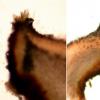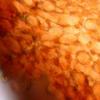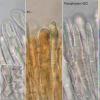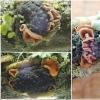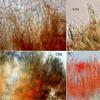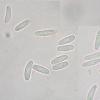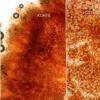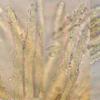
24-12-2025 17:08
Hulda Caroline HolteHello, I have found this propoloid ascomycete on

21-12-2025 09:32
Hello.A tiny ascomycete found embedded in wood in

21-12-2025 21:32
Pol DebaenstHello, Garden, Burgweg 19, Veurne, BelgiumOn 10/1

22-12-2025 23:38
Patrice TANCHAUDBonsoir, récolte sur un mur en pierre, apothéci

22-12-2025 00:47
Patrice TANCHAUDBonsoir, récolte à proximité du milieu dunaire

Bonjour,
Voici une Helotiale manifestement liée au pyrenomycète Camarosporidiella laburni (det. A. Gardiennet) et qui évoque donc un Unguiculariopsis.
Mais ! Les caractères micro ne sont guère compatibles avec le genre, voire peut être même avec la famille des Cordieritidaceae ??
ApOthecia up to 2,5 mm . gregarious, Ascus H- and IKI - 75-95 µm. PS 30 µm Spores cylindrical to slightly allantoid, OCI 1-1,5 . 11-13 x 2,8-31 µm. PAraphyses rather lanceolate, septate, covered with amorphic hyaline matter , with no VB visible in water but some patches are stained in CRB.
Medulla T. intricata of almost parallel hyphes x 2-3 µm . Ectal of globose cells x6-12 µm covered with amorphic red-brown matter. Margin hairs up to 150 µm x 3-7 , walls red-brown and granulous as in LAchnum (!) , which can be seen after KOH or in Congo Red. KOH dissolves the brown pigment . No ionomidotic reaction, no cristals.
Toute aide sera bienvenue. Amitiés. Michel

not easy case! But you say the brown pigment dissolves in KOH. If so, it should extrude in the medium, does it? But you say "not ionomidotic"?
could you show some hairs in closeup to better see the warts?
Various characters tell agains Unguiculariopsis, including absence of croziers, warted sublanceolate paraphyses, dissolvable pigment, and hair features. But the family I think is correct.
Zotto

As the hairs are strongly agglutinate , I tried KOH to gain visibility but may be the pigments are not actually dissolved. I do not notice that they extrude .
here is a comparison between KOH 5% and tap water. I also tried closeups . These warts seem not firmly fixed to hair walls.
Michel


I wonder why my answer does not appear...
Yes Zotto, the comparison shows similarity.
A sequence is sheduled. Hope we can get a clear result.
THanks again . Michel
